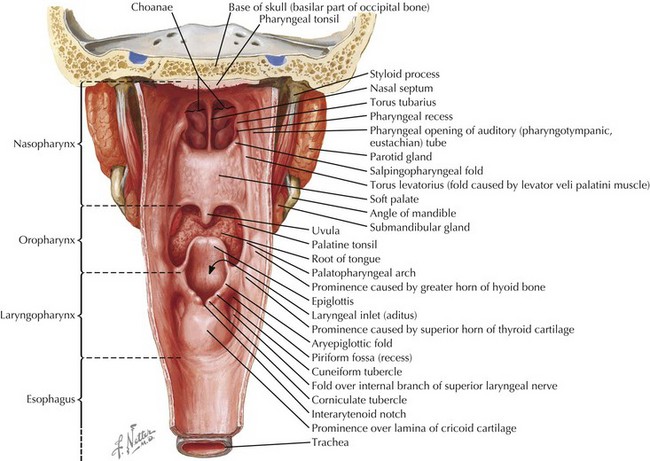35 Pharyngitis
Pharyngitis is an inflammation of the mucous membranes and submucosal structures of the pharynx, including the nasopharynx, oropharynx, and laryngopharynx (Figure 35-1). It accounts for approximately 7.3 million outpatient childhood doctor’s visits each year, and it remains one of the most common reasons for which children and adolescents seek medical attention. The cause of pharyngitis can vary widely depending on a person’s comorbidities, season of year, and exposure history, and the goals of diagnosis and management are to correctly treat the cases that require medical intervention and minimize the risk of long-term complications that may result from a primary pharyngitis. Yet despite the fever, sore throat, malaise, and associated symptoms that are often distressing to patients and their families, most cases of pharyngitis are benign and self-limited.
Etiology and Pathogenesis
There are numerous causes of pharyngitis, including infection, allergic rhinitis, environmental exposures, gastroesophageal reflux, and malignancy. The most common type of pharyngitis, however, is acute infectious pharyngitis, which is the focus of this chapter (Table 35-1). Viral infectious account for 40% to 60% of pediatric pharyngitis and usually present as part of a larger viral syndrome. Rhinovirus, adenovirus, and coronavirus, for example, present with sore throat along with fever, rhinorrhea, and other cold symptoms. Pharyngitis secondary to Epstein-Barr virus (EBV), on the other hand, commonly presents in adolescents and young adults as a symptom of mononucleosis syndrome.
Table 35-1 Common Causes of Acute Infectious Pharyngitis
| Viral | Bacterial | Other Pathogens |
|---|---|---|
| Rhinovirus | GABHS | Mycobacterium tuberculosis |
| Adenovirus | Non-GABHS (group C and G) | Candida albicans |
| Coronavirus | Neisseria gonorrhoeae | Mycoplasma pneumoniae |
| RSV | Corynebacterium diphtheriae | |
| HSV | Arcanobacterium haemolyticum | |
| Parainfluenza | Francisella tularensis | |
| Influenza | Chlamydia pneumoniae | |
| Enterovirus | ||
| EBV | ||
| CMV | ||
| HIV |
CMV, cytomegalovirus; EBV, Epstein-Barr virus; GABHS, group A β-hemolytic streptococci; HSV, herpes simplex virus; RSV, respiratory syncytial virus.
Alternatively, various bacteria may cause acute infectious pharyngitis. Streptococcus pyogenes, also known as group A β-hemolytic streptococci (GABHS), is the most common bacterial cause of pharyngitis. It accounts for 15% to 30% of pediatric pharyngitis and is an important pathogen to identify because treatment is essential in reducing the risk of postinfectious complications. Other common bacterial pathogens as well as a few fungal pathogens that can cause pharyngitis are listed in Table 35-1.
Clinical Presentation
The presenting signs and symptoms surrounding pharyngitis can vary from one patient to another, yet some clinical findings are fairly typical of acute infectious pharyngitis. The most common findings in those with infectious pharyngitis include a history of fever; cervical lymphadenopathy; and oropharyngeal or tonsillar erythema, enlargement, or exudates (Figure 35-2). Although no definitive clinical presentations can correctly identify the cause of an individual’s pharyngitis, various signs and symptoms are more characteristic of one pathogen than another. These common presentations include:
Stay updated, free articles. Join our Telegram channel

Full access? Get Clinical Tree



